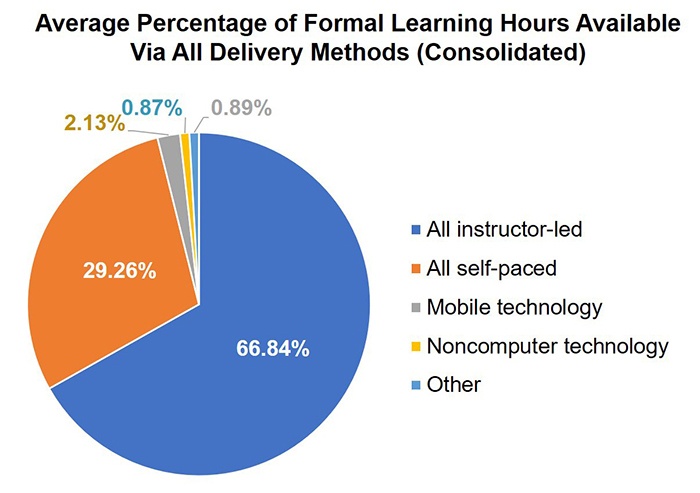How Much Of Mobile Learning Is Happening?
Not much, really! We have been talking about mobile learning, since the early 2000s and we continue discussing it ad nauseam at conferences and training events even today. Most times, we hear hosannas being sung about it—how convenient, engaging, cost-effective it is and how much organizations are into it.
It is true that mobile technologies have witnessed huge changes in the last decade. Mobile devices have morphed into tablets and phablets, performing tasks that were once unique to only phones or personal computers. Together with internet technologies, mobile technologies have changed the way people learn new things.

Average percentage of formal learning hours available via all delivery methods (State of Industry Report of ATD, 2018)
Despite all the hullabaloo that continues, mobile learning (the delivery of content specifically using mobile technology such as smartphones and tablets) accounted for only about 2% of the total learning hours used and available in an organization in 2018. It made up less than half of the percent of the hours used and available in 2016 and 3% of the hours available and used in 2015. The percentage may be a little higher if you consider that some self-paced online learning courses that are not specifically designed for mobile may be consumed by learners using an internet browser on a mobile device.
What Is Mobile Learning For You, Personally?
It’s 7:00 am in Brownsville, TX. You are getting ready for a business meeting in your hotel room. You have arrived the previous night from NYC to meet Dave H., the new Head of manufacturing of a string of factories your company has across the Mexican border. It is an important meeting for you as the company’s grapevine whispered that David does not have a particularly high opinion of Learning and Development. So, understandably you want to make the meeting count and leave the most favorable impression possible.
As you are about to step out, you notice that your jacket is covered with a patina of pink lint on the entire left sleeve. Pink lint on a blue jacket, for God’s sake! You remember the woman with a pink shawl who sat beside you in the flight. Of course, your toiletries pouch doesn’t include a lint brush and the front desk cannot help you here. What do you do?
Grab your iPhone and google, "how to remove lint?" and get 27,600,000 hits in 0.63 seconds. The very first link, a 109 second YouTube video, teaches you how to do it with scotch tape, which the hotel’s front desk helpfully sends you. In exactly 10 minutes from the time you discovered your problem, you solved it. Not just that, you quickly posted a comment that "for best results, use a 1” scotch tape and not the ½” one."
I don’t have reliable statistics but I am willing to wager that today, we learn exponentially a lot more than before, and we do it mostly by ourselves, thanks to the ubiquitous digital learning ecosystem that is mobile, interconnected, and interactive, real-time, with abundant User-Generated Content, providing convenient, expedient, and immediate learning. That’s mobile learning for you. But is this how it is seen by corporate organizations?
What Is Mobile Learning For You, The Training Manager?
As part of my doctoral studies, I researched 3 multinational organizations with more than 100,000 employees each. According to their training managers, mobile learning happens when the learner is using any mobile device while on the move. The main benefit is its ubiquity and ability to reach a large number of people. So far so good. But let’s see how they are using mobile learning:
- To teach something new quickly
- Ideal for refresher training
- For performance support and as job-aids rather than for traditional learning
- Used to build on primary training in the classroom
- For topics requiring immediate access to knowledge
- For piquing the learners’ interest
- For learning that could be easily absorbed
- Can be immediately applied to resolve work-related issues
- Unsuitable for difficult topics requiring "serious and heavy" classroom training
- For people without access to computers or the internet but who have a cell phone
It appears that in general, mobile learning is being implemented as part of eLearning, which is possibly the reason mobile learning is not perceived as an entirely new way of learning. They see mobile learning essentially as a method to teach—and/or reinforce—small bits of knowledge. It is definitely not for substantial learning and surely cannot stand on its own.
It has to be blended with either classroom training or conventional eLearning. And nobody talks about User-Generated Content. It is still the "sage-on-the-stage" approach; does anyone really believe the "guide-on-the-side"? We are still in antediluvian times when the "big brother" company will decide what its employees should learn, sermonizing about adult learning in the same breath.
It is easy to see what’s happening here. Training managers are still seeing mobile learning from the lens of eLearning through the eyes of classroom training, much like how early Hollywood directors shot their movies on a theater stage.

Image Courtesy: USC Libraries - California Historical Society Collection
Understandably so, as without exception, organizations with established eLearning are the ones that initiate mobile learning, at least on a serious note. They continue to see it from a techno-centric perspective – the small screen size, difficulty in inputting data, and limited memory, along with the inability of mobile devices to run Adobe Flash. When mobile learning is seen this way, it puts blinkers, restricting us from seeing mobile learning in its most perfect embodiment.
So, What Mobile Learning Can Really Be (According To The Pundits)
Ok. Let’s agree we are confused about what we mean by mobile learning. Is it eLearning on a mobile device? An extension of eLearning? Or is it any learning on a mobile device? Some think mobile learning is just an extension or a subset of eLearning through mobile devices and the natural evolution of eLearning.
The pundits, however, think mobile learning is something wholly different, with new paradigms of teaching and learning [1]. Mobile learning was initially defined in terms of its features: being personal, portable, spontaneous, opportunistic, informal, pervasive, situated, private, context-aware, and bite-sized.
These features are quite different from the conventional and "tethered" eLearning which often is structured, media-rich, broadband, interactive, intelligent, and usable. A definition that tries to include both sets of features would blur the distinction between mobile learning and eLearning.

Traxler’s model - commonalities and differences between e-learning and mobile learning Adapted from Traxler’s Model (Traxler, 2005)
Here are some "enlightened" definitions:
- Any sort of learning that happens when the learner is not at a fixed, predetermined location, or learning that happens when the learner takes advantage of learning opportunities offered by mobile technologies [2].
- An intersection of mobile computing and eLearning: accessible resources wherever you are, strong search capabilities, rich interaction, powerful support for effective learning, and performance-based assessment. eLearning is independent of location in time or space [3].
- An ambient computing environment of a multitude of systems, devices, and people who can access, communicate, and share content from anywhere and anytime, both synchronously and asynchronously [4].
Mobile learning is a ubiquitous process by which humans acquire, assimilate, share, store, retrieve, and use knowledge and information by using and interacting with other humans, ICT, and mobile technology. The learners are connected, interactive, and mobile; the learning is spontaneous, personalized, private, situated, informal, and of short-duration; the learning content is digital, bite-sized, media-rich, engaging and constantly evolving; the devices are feature-rich, portable, and light-weight.
So, this is the most perfect avatar of mobile learning. It’s not just learning on a mobile device when you are on the move. It is an entire digital mobile learning ecosystem that is mobile, interconnected, interacted, real-time, providing convenient, expedient, immediate and constantly evolving learning content, that is just-enough, just-for-me, just-now, and just-here. At this level, a person can practically learn anything, not just small, easy-to-learn nuggets. People learn pretty serious stuff—languages, STEM, art, musical instruments, a Ph.D. (I am serious)—literally anything, limited only by one’s imagination, and that’s not all, most of it actually for free.
Parting Shots
Close your eyes and imagine creating the same digital mobile learning ecosystem where employees can decide what they want to learn or solve work-related problems, efficiently and effectively, sharing their experiences spontaneously and speedily, keeping the learning content fresh and relevant. The same way millions do it on Google, like how you solved your "flint-on-the-jacket" problem or learned Japanese well enough to pass the JLPT N1 exam. So, what’s stopping organizations from recreating the "mobile phone-internet-google" model?
I'd love to hear from you about what you think…and standby for my thoughts in my next article.
References:
[1] Kukulska-Hulme, A., Sharples, M., Milrad, M., Arnedillo-Sánchez, I., & Vavoula, G. 2009. "Innovation in mobile learning: A European perspective" International Journal of Mobile and Blended Learning (IJMBL), 1, pp. 13-35.
[2] O'Malley, C., Vavoula, G., Glew, J., Taylor, J., Sharples, M., Lefrere, P., Waycott, J. et al. 2005. Guidelines for learning/teaching/tutoring in a mobile environment.
[3] Quinn, C. 2000. "mLearning: Mobile, Wireless, In-Your-Pocket Learning."
[4] Hummel, K. A.,– Hlavacs, H. 2003. "Anytime, anywhere learning behavior using a web-based platform for a university lecture" SSGRR 2003 Winter Conference, L’Aquila, Italy.
Sources:
- ATD. 2018. 2018 State of the Industry <https://www.td.org/research-reports/2018-state-of-the-industry>.
- Traxler, J. 2005. "Defining mobile learning." IADIS International Conference Mobile Learning, pp. 261-266.

